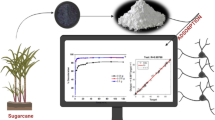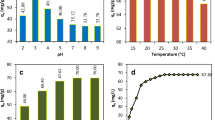Abstract
The present study investigated statistical modeling and the optimization of process parameters for the adsorption of methylene blue (MB) dye onto waste-derived chemically activated biosorbents. The synthesized biosorbents has been characterized via field emission scanning electron microscopy (FESEM), energy-dispersive X-ray spectroscopy (EDX), Fourier transform infrared spectroscopy (FTIR), and Brunauer–Emmett–Teller (BET) analysis. A batch adsorption study has been performed at different operating conditions including the effect of biosorbent dose, pH, contact time, and concentration of MB dye on its removal. Different isotherm and kinetic models were also investigated, among them the Freundlich and Temkin isotherm, better optimize the equilibrium data. The maximum adsorption capacity recorded for ZnCl2_AC, H3PO4_AC, NaOH_AC, and NON_AC are 324.58, 233.11, 129.25, and 55.11 mg/g, respectively. The kinetic investigation exhibited that the adsorption behavior followed the intraparticle-diffusion model, signifying that the intraparticle diffusional resistance within the porous biosorbent controls the MB dye adsorption mechanism. The response surface methodology and artificial neural network approach were used to optimize the process parameters for the removal of MB dye in terms of response variables. Among the 20 designed experimental operating conditions, pH 9, sorbent dose 3 g/L, and a contact time of 8 h show optimum removal percentage of MB dye. The point of zero charges was also investigated to understand the surface chemistry of biosorbent. The high adsorption capacity obtained for ZnCl2_AC indicates that an appropriate low-cost biosorbent can be utilized for the removal of methylene blue dye from the aqueous solution.
Graphical abstract















Similar content being viewed by others
References
Yadav S, Yadav A, Bagotia N et al (2022) Novel composites of Pennisetum glaucum with CNT: preparation, characterization and application for the removal of safranine O and methylene blue dyes from single and binary systems. Biomass Convers Biorefinery. https://doi.org/10.1007/s13399-021-02240-z
Kumar V, Saharan P, Sharma AK et al (2020) Silver doped manganese oxide-carbon nanotube nanocomposite for enhanced dye-sequestration: isotherm studies and RSM modelling approach. Ceram Int 46:10309–10319. https://doi.org/10.1016/j.ceramint.2020.01.025
Kumar V, Saharan P, Sharma AK et al (2020) Silver embellished PANI/CNT nanocomposite for antimicrobial activity and sequestration of dye based on RSM modelling. Environ Technol (United Kingdom) 41:2991–3003. https://doi.org/10.1080/09593330.2019.1593512
Yadav S, Yadav A, Bagotia N et al (2021) Adsorptive potential of modified plant-based adsorbents for sequestration of dyes and heavy metals from wastewater – a review. J. Water Process Eng. 42:102148
Mittal J, Mariyam A, Sakina F et al (2021) Batch and bulk adsorptive removal of anionic dye using metal/halide-free ordered mesoporous carbon as adsorbent. J Clean Prod 321:129060. https://doi.org/10.1016/j.jclepro.2021.129060
Patel P, Muteen A, Mondal P (2020) Treatment of greywater using waste biomass derived activated carbons and integrated sand column. Sci Total Environ 711. https://doi.org/10.1016/j.scitotenv.2019.134586
Zhang W, Lan Y, Ma M et al (2020) A novel chitosan–vanadium–titanium–magnetite composite as a superior adsorbent for organic dyes in wastewater. Environ Int 142.https://doi.org/10.1016/j.envint.2020.105798
Danish M, Ahmad T, Hashim R et al (2018) Comparison of surface properties of wood biomass activated carbons and their application against rhodamine B and methylene blue dye. Surf Interfaces 11:1–13. https://doi.org/10.1016/j.surfin.2018.02.001
Zubir MHM, Zaini MAA (2020) Twigs-derived activated carbons via H3PO4/ZnCl2 composite activation for methylene blue and congo red dyes removal. Sci Rep 10:14050. https://doi.org/10.1038/s41598-020-71034-6
Benhabiles S, Rida K (2021) Production of efficient activated carbon from sawdust for the removal of dyes in single and binary systems – a full factorial design. Part Sci Technol 39:237–251. https://doi.org/10.1080/02726351.2019.1711475
Ribas MC, de Franco MAE, Adebayo MA et al (2020) Adsorption of Procion Red MX-5B dye from aqueous solution using homemade peach and commercial activated carbons. Appl Water Sci 10:154. https://doi.org/10.1007/s13201-020-01237-9
Abid MF, Zablouk MA, Abid-Alameer AM (2012) Experimental study of dye removal from industrial wastewater by membrane technologies of reverse osmosis and nanofiltration. Iran J Environ Heal Sci Eng 9. https://doi.org/10.1186/1735-2746-9-17
Durairaj S (2014) Role of Lemna minor Lin. in treating the textile industry wastewater. ResearchgateNet 55–59
Timur S, Kantarli IC, Ikizoglu E, Yanik J (2006) Preparation of activated carbons from Oreganum stalks by chemical activation. Energy Fuels 20:2636–2641. https://doi.org/10.1021/ef060219k
Du H, Cheng J, Wang M et al (2020) Red dye extracted sappan wood waste derived activated carbons characterization and dye adsorption properties. Diam Relat Mater 102:107646. https://doi.org/10.1016/j.diamond.2019.107646
Hock PE, Zaini MAA (2018) Activated carbons by zinc chloride activation for dye removal – a commentary. Acta Chim Slovaca 11:99–106. https://doi.org/10.2478/acs-2018-0015
Gupta S, Patel P, Mondal P (2022) Biofuels production from pine needles via pyrolysis: process parameters modeling and optimization through combined RSM and ANN based approach. Fuel 310:122230. https://doi.org/10.1016/j.fuel.2021.122230
Kumar R, Mudhoo A, Lofrano G, Chandra M (2014) Journal of Environmental Chemical Engineering Biomass-derived biosorbents for metal ions sequestration: Adsorbent modification and activation methods and adsorbent regeneration. Biochem Pharmacol 2:239–259. https://doi.org/10.1016/j.jece.2013.12.019
Gupta S, Lanjewar R, Mondal P (2022) Enhancement of hydrocarbons and phenols in catalytic pyrolysis bio-oil by employing aluminum hydroxide nanoparticle based spent adsorbent derived catalysts. Chemosphere 287:132220. https://doi.org/10.1016/j.chemosphere.2021.132220
Rathore VK, Mondal P (2017) Competitive adsorption of arsenic and fluoride onto economically prepared aluminum oxide/hydroxide nanoparticles: multicomponent isotherms and spent adsorbent management. Ind Eng Chem Res 56:8081–8094. https://doi.org/10.1021/acs.iecr.7b01139
Adegoke KA, Bello OS (2015) Dye sequestration using agricultural wastes as adsorbents. Water Resour Ind 12:8–24. https://doi.org/10.1016/j.wri.2015.09.002
Mondal P, Mohanty B, B. Majumder C (2013) Effect of pH and treatment time on the removal of arsenic species from simulated groundwater by using Fe3+ and Ca2+ impregnated granular activated charcoals. Chem Eng Sci 1:27–31. https://doi.org/10.12691/ces-1-2-3
Namasivayam C, Sangeetha D (2006) Removal of molybdate from water by adsorption onto ZnCl2 activated coir pith carbon. Bioresour Technol 97:1194–1200. https://doi.org/10.1016/j.biortech.2005.05.008
Ozdemir I, Şahin M, Orhan R, Erdem M (2014) Preparation and characterization of activated carbon from grape stalk by zinc chloride activation. Fuel Process Technol 125:200–206. https://doi.org/10.1016/j.fuproc.2014.04.002
Ahsan MA, Jabbari V, Islam MT et al (2018) Green synthesis of a highly efficient biosorbent for organic, pharmaceutical, and heavy metal pollutants removal: engineering surface chemistry of polymeric biomass of spent coffee waste. J Water Process Eng 25:309–319. https://doi.org/10.1016/j.jwpe.2018.08.005
Kannaujiya MC, Gupta GK, Mandal T, Mondal MK (2022) Adsorption of Acid Yellow 2GL dye from simulated water using brinjal waste. Biomass Convers Biorefinery. https://doi.org/10.1007/s13399-021-02131-3
Tu JV (1996) Advantages and disadvantages of using artificial neural networks versus logistic regression for predicting medical outcomes. J Clin Epidemiol 49:1225–1231. https://doi.org/10.1016/S0895-4356(96)00002-9
Wang L, Chen Z, Wen H et al (2018) Microwave assisted modification of activated carbons by organic acid ammoniums activation for enhanced adsorption of acid red 18. Powder Technol 323:230–237. https://doi.org/10.1016/j.powtec.2017.10.021
Foo KY, Hameed BH (2011) Utilization of rice husks as a feedstock for preparation of activated carbon by microwave induced KOH and K2CO3 activation. Bioresour Technol 102:9814–9817. https://doi.org/10.1016/j.biortech.2011.07.102
Foo KY, Hameed BH (2012) Preparation, characterization and evaluation of adsorptive properties of orange peel based activated carbon via microwave induced K2CO3 activation. Bioresour Technol 104:679–686. https://doi.org/10.1016/j.biortech.2011.10.005
Medhat A, El-Maghrabi HH, Abdelghany A et al (2021) Efficiently activated carbons from corn cob for methylene blue adsorption. Appl Surf Sci Adv 3:100037. https://doi.org/10.1016/j.apsadv.2020.100037
Li L, Wu M, Song C et al (2021) Efficient removal of cationic dyes via activated carbon with ultrahigh specific surface derived from vinasse wastes. Bioresour Technol 322:124540. https://doi.org/10.1016/j.biortech.2020.124540
Daoud M, Benturki O, Kecira Z et al (2017) Removal of reactive dye (BEZAKTIV Red S-MAX) from aqueous solution by adsorption onto activated carbons prepared from date palm rachis and jujube stones. J Mol Liq 243:799–809. https://doi.org/10.1016/j.molliq.2017.08.093
Yadav A, Bagotia N, Yadav S et al (2021) Adsorptive studies on the removal of dyes from single and binary systems using Saccharum munja plant-based novel functionalized CNT composites. Environ Technol Innov 24:102015. https://doi.org/10.1016/j.eti.2021.102015
Acknowledgements
The authors acknowledge the Indian Institute of Technology (IIT) Roorkee, Roorkee, India, for furnishing necessary resources and financial support to accomplish the reported work.
Author information
Authors and Affiliations
Contributions
PP: experimentation/investigation, data analysis, methodology, conceptualization, writing (original draft preparation), visualization, writing (reviewing and editing); SG: visualization, writing (reviewing and editing), manuscript interpretation; PM: supervision, conceptualization, visualization, writing (reviewing and editing), resources.
Corresponding author
Ethics declarations
Conflict of interest
The authors declare no competing interests.
Additional information
Publisher's note
Springer Nature remains neutral with regard to jurisdictional claims in published maps and institutional affiliations.
Supplementary Information
Below is the link to the electronic supplementary material.
Rights and permissions
About this article
Cite this article
Patel, P., Gupta, S. & Mondal, P. Modeling and optimization of process parameters of MB dye adsorption using waste-derived chemically activated biosorbents. Biomass Conv. Bioref. 13, 13461–13480 (2023). https://doi.org/10.1007/s13399-022-02693-w
Received:
Revised:
Accepted:
Published:
Issue Date:
DOI: https://doi.org/10.1007/s13399-022-02693-w




